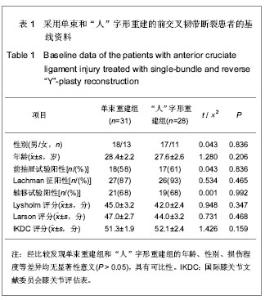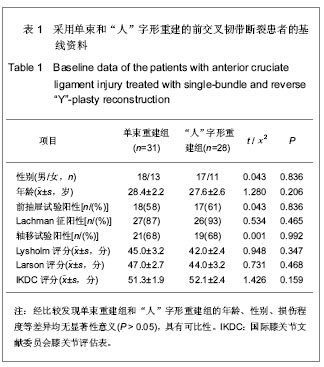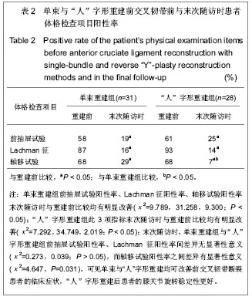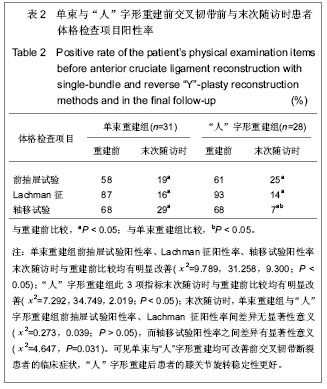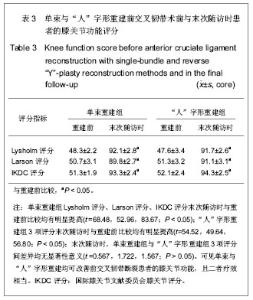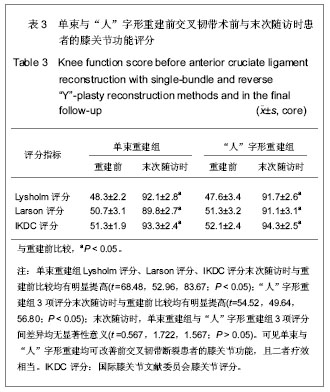Chinese Journal of Tissue Engineering Research ›› 2013, Vol. 17 ›› Issue (18): 3341-3348.doi: 10.3969/j.issn.2095-4344.2013.18.016
Previous Articles Next Articles
Long-term effect of the single-bundle versus reverse “Y”-plasty reconstruction method for the anterior cruciate ligament reconstruction
Wang Li-hui, Li Wei-ping, Song Bin, Yang Rui, Chen Zhong
- Department of Sport Medicine, Sun Yat-Sen Memorial Hospital, Sun Yat-sen University, Guangzhou 510120, Guangdong Province, China
-
Received:2013-03-04Revised:2013-03-25Online:2013-04-30Published:2013-04-30 -
Contact:Li Wei-ping, Chief physician, Department of Sport Medicine, Sun Yat-Sen Memorial Hospital, Sun Yat-sen University, Guangzhou 510120, Guangdong Province, China lwp63@163.com -
About author:Wang Li-hui★, Studying for master’s degree, Department of Sport Medicine, Sun Yat-Sen Memorial Hospital, Sun Yat-sen University, Guangzhou 510120, Guangdong Province, China wangody@126.com -
Supported by:Social Development Project of Guangdong Provincial Science and Technology Program, No. 2011B031800017
CLC Number:
Cite this article
Wang Li-hui, Li Wei-ping, Song Bin, Yang Rui, Chen Zhong. Long-term effect of the single-bundle versus reverse “Y”-plasty reconstruction method for the anterior cruciate ligament reconstruction[J]. Chinese Journal of Tissue Engineering Research, 2013, 17(18): 3341-3348.
share this article
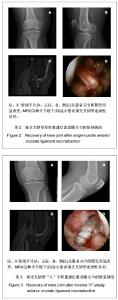
2.5 单束和“人”字形重建对前交叉韧带断裂患者膝关节前后向稳定性的影响 单束重建组末次随访时患膝胫骨前向位移Kneelax测量结果为(4.6±0.7) mm,健膝为(4.3±0.8) mm,两侧比较差异无显著性意义(P > 0.05);“人”字形重建组末次随访时患膝胫骨前向位移Kneelax测量结果为(4.4±0.6) mm,健膝为(4.2±0.5) mm,两侧比较差异无显著性意义(P > 0.05)。且单束重建组与“人”字形重建组比较,患膝的胫骨前向位移值间差异无显著性意义(P > 0.05)。 2.6 单束和“人”字形重建对患者前交叉韧带的修复情况 末次随访复查X射线平片见所有患者关节间隙无明显改变,MRI显示所有患者前交叉韧带连续性良好,见图2,3。"
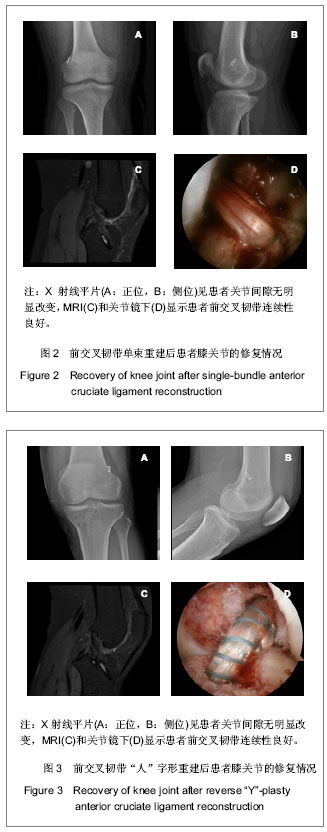
| [1] Gianotti SM, Marshall SW, Hume PA, et al. Incidence of anterior cruciate ligament injury and other knee ligament injuries: a national population-based study. J Sci Med Sport. 2009;12(6): 622-627.[2] Aichroth PM, Patel DV, Zorrilla P. The natural history and treatment of rupture of the anterior cruciate ligament in children and adolescents. A prospective review. J Bone Joint Surg Br. 2002;84(1):38-41.[3] Peña E, Martínez MA, Calvo B, et al. A finite element simulation of the effect of graft stiffness and graft tensioning in ACL reconstruction. Clin Biomech (Bristol, Avon). 2005;20(6): 636-644.[4] Li WP, Huang JR, Shen HY, et al. Disan Junyi Daxue Xuebao. 2008;30(15):1404-1407.李卫平,黄建荣,沈慧勇,等.关节镜下六股自体腘绳肌肌腱胫骨双隧道重建膝前交叉韧带[J].第三军医大学学报,2008,30(15): 1404-1407.[5] Li WP, Song B, Huang JR, et al. Zhongguo Neijing Zazhi. 2009;15(8):796-800.李卫平,宋斌,黄建荣,等.关节镜下胫骨双隧道股骨单隧道八股同种异体肌腱重建膝前交叉韧带[J].中国内镜杂志,2009,15(8): 796-800.[6] Mirzatolooei F. Comparison of short term clinical outcomes between transtibial and transportal TransFix® femoral fixation in hamstring ACL reconstruction. Acta Orthop Traumatol Turc. 2012;46(5):361-366.[7] Paine R, Lowe W. Comparison of Kneelax and KT-1000 knee ligament arthrometers. J Knee Surg. 2012;25(2):151-154.[8] Meisterling SW, Schoderbek RJ, Andrews JR. Anterior cruciate ligament reconstruction. Oper Tech Sports Med. 2009; 17:2-10. [9] Girgis FG, Marshall JL, Monajem A. The cruciate ligaments of the knee joint. Anatomical, functional and experimental analysis. Clin Orthop Relat Res. 1975;(106):216-231.[10] Shen W, Jordan S, Fu F. Review article: anatomic double bundle anterior cruciate ligament reconstruction. J Orthop Surg (Hong Kong). 2007;15(2):216-221.[11] Verhelst L, Van Der Bracht H, Oosterlinck D, et al. ACL repair with a single or double tunnel: a comparative laboratory study of knee stability using computer navigation. Acta Orthop Belg. 2012;78(6):771-778.[12] Georgoulis AD, Ristanis S, Chouliaras V, et al. Tibial rotation is not restored after ACL reconstruction with a hamstring graft. Clin Orthop Relat Res. 2007;454:89-94.[13] Yagi M, Kuroda R, Nagamune K, et al. Double-bundle ACL reconstruction can improve rotational stability. Clin Orthop Relat Res. 2007;454:100-107.[14] Radford WJ, Amis AA. Biomechanics of a double prosthetic ligament in the anterior cruciate deficient knee. J Bone Joint Surg Br. 1990;72(6):1038-1043.[15] Hussein M, van Eck CF, Cretnik A, et al. Individualized anterior cruciate ligament surgery: a prospective study comparing anatomic single- and double-bundle reconstruction. Am J Sports Med. 2012;40(8):1781-1788.[16] Zelle BA, Brucker PU, Feng MT, et al. Anatomical double-bundle anterior cruciate ligament reconstruction. Sports Med. 2006;36(2):99-108.[17] Nelson JD, Hogan MV, Miller MD. What's new in sports medicine. J Bone Joint Surg Am. 2010;92(1):250-263.[18] Muneta T, Koga H, Morito T, et al. A retrospective study of the midterm outcome of two-bundle anterior cruciate ligament reconstruction using quadrupled semitendinosus tendon in comparison with one-bundle reconstruction. Arthroscopy. 2006;22(3):252-258.[19] Branch TP, Siebold R, Freedberg HI, et al. Double-bundle ACL reconstruction demonstrated superior clinical stability to single-bundle ACL reconstruction: a matched-pairs analysis of instrumented tests of tibial anterior translation and internal rotation laxity. Knee Surg Sports Traumatol Arthrosc. 2011;19 (3):432-440.[20] Kondo E, Merican AM, Yasuda K, et al. Biomechanical comparisons of knee stability after anterior cruciate ligament reconstruction between 2 clinically available transtibial procedures: anatomic double bundle versus single bundle. Am J Sports Med. 2010;38(7):1349-1358.[21] Zelle BA, Vidal AF, Brucker PU, et al. Double-bundle reconstruction of the anterior cruciate ligament: anatomic and biomechanical rationale. J Am Acad Orthop Surg. 2007;15(2) 87-96.[22] Ahn JH, Lee SH. Anterior cruciate ligament double-bundle reconstruction with hamstring tendon autografts. Arthroscopy. 2007;23(1):109.e1-4.[23] Iriuchishima T, Tajima G, Shirakura K, et al. In vitro and in vivo AM and PL tunnel positioning in anatomical double bundle anterior cruciate ligament reconstruction. Arch Orthop Trauma Surg. 2011;131(8):1085-1090.[24] Petersen W, Tretow H, Weimann A, et al. Biomechanical evaluation of two techniques for double-bundle anterior cruciate ligament reconstruction: one tibial tunnel versus two tibial tunnels. Am J Sports Med. 2007;35(2):228-234.[25] Pederzini L, Adriani E, Botticella C, et al. Technical note: double tibial tunnel using quadriceps tendon in anterior cruciate ligament reconstruction. Arthroscopy. 2000;16(5):E9.[26] Ping LW, Bin S, Rui Y, et al. Arthroscopic ACL reconstruction with reverse "Y"-plasty grafts and fixation in the femur with either a bioabsorbable interference screw or an Endobutton. Knee. 2012;19(2):78-83.[27] Li WP, Song B, Yang R, et al. Zhonghua Chuangshang Guke Zazhi. 2010;12(4):13-17.李卫平,宋斌,杨睿,等.关节镜下纽扣固定“人”字形移植物重建前交叉韧带的初步报告[J].中华创伤骨科杂志,2010,12 (4):13-17.[28] Willem M, Richard PB. Clinical outcome of double-bundle anterior cruciate ligament reconstruction. Am J Sports Med. 2008;16:171-175.[29] Colombet P, Robinson J, Christel P, et al. Using navigation to measure rotation kinematics during ACL reconstruction. Clin Orthop Relat Res. 2007;454:59-65.[30] Zantop T, Wellmann M, Fu FH, et al. Tunnel positioning of anteromedial and posterolateral bundles in anatomic anterior cruciate ligament reconstruction: anatomic and radiographic findings. Am J Sports Med. 2008;36(1):65-72.[31] Irrgang JJ, Tashman S, Moore C, et al. Challenge accepted: description of an ongoing NIH-funded randomized clinical trial to compare anatomic single-bundle versus anatomic double-bundle ACL reconstruction. Arthroscopy. 2012;28(6): 745-748.[32] Meredick RB, Vance KJ, Appleby D, et al. Outcome of single-bundle versus double-bundle reconstruction of the anterior cruciate ligament: a meta-analysis. Am J Sports Med. 2008;36(7):1414-1421.[33] van Eck CF, Kopf S, Irrgang JJ, et al. Single-bundle versus double-bundle reconstruction for anterior cruciate ligament rupture: a meta-analysis--does anatomy matter? Arthroscopy. 2012;28(3):405-424. |
| [1] | Huang Dengcheng, Wang Zhike, Cao Xuewei. Comparison of the short-term efficacy of extracorporeal shock wave therapy for middle-aged and elderly knee osteoarthritis: a meta-analysis [J]. Chinese Journal of Tissue Engineering Research, 2021, 25(9): 1471-1476. |
| [2] | Zhang Shangpu, Ju Xiaodong, Song Hengyi, Dong Zhi, Wang Chen, Sun Guodong. Arthroscopic suture bridge technique with suture anchor in the treatment of acromioclavicular dislocation [J]. Chinese Journal of Tissue Engineering Research, 2021, 25(9): 1417-1422. |
| [3] | Zhong Hehe, Sun Pengpeng, Sang Peng, Wu Shuhong, Liu Yi. Evaluation of knee stability after simulated reconstruction of the core ligament of the posterolateral complex [J]. Chinese Journal of Tissue Engineering Research, 2021, 25(6): 821-825. |
| [4] | Liu Shaohua, Zhou Guanming, Chen Xicong, Xiao Keming, Cai Jian, Liu Xiaofang. Influence of anterior cruciate ligament defect on the mid-term outcome of fixed-bearing unicompartmental knee arthroplasty [J]. Chinese Journal of Tissue Engineering Research, 2021, 25(6): 860-865. |
| [5] | Zhang Lei, Ma Li, Fu Shijie, Zhou Xin, Yu Lin, Guo Xiaoguang. Arthroscopic treatment of greater tuberosity avulsion fractures with anterior shoulder dislocation using the double-row suture anchor technique [J]. Chinese Journal of Tissue Engineering Research, 2021, 25(6): 895-900. |
| [6] | Huang Dengcheng, Wang Zhike, Cao Xuewei. Intravenous, topical tranexamic acid alone or their combination in total knee arthroplasty: a meta-analysis of randomized controlled trials [J]. Chinese Journal of Tissue Engineering Research, 2021, 25(6): 948-956. |
| [7] | He Xiangzhong, Chen Haiyun, Liu Jun, Lü Yang, Pan Jianke, Yang Wenbin, He Jingwen, Huang Junhan. Platelet-rich plasma combined with microfracture versus microfracture in the treatment of knee cartilage lesions: a meta-analysis [J]. Chinese Journal of Tissue Engineering Research, 2021, 25(6): 964-969. |
| [8] | Liu Xin, Yan Feihua, Hong Kunhao. Delaying cartilage degeneration by regulating the expression of aquaporins in rats with knee osteoarthritis [J]. Chinese Journal of Tissue Engineering Research, 2021, 25(5): 668-673. |
| [9] | Xie Chongxin, Zhang Lei. Comparison of knee degeneration after anterior cruciate ligament reconstruction with or without remnant preservation [J]. Chinese Journal of Tissue Engineering Research, 2021, 25(5): 735-740. |
| [10] | Yang Xin, Jin Zhe, Feng Xu, Lu Bing. The current situation of knowledge and attitudes towards organ, eye tissue, body donation of residents in Shenyang [J]. Chinese Journal of Tissue Engineering Research, 2021, 25(5): 779-784. |
| [11] | Ma Ziyue, Ju Xiaochen, Zhang Lei, Sun Rongxin. Tendon-bone healing in anterior cruciate ligament reconstruction with and without remnant preservation [J]. Chinese Journal of Tissue Engineering Research, 2021, 25(4): 582-587. |
| [12] | Wang Weigang, Yang Zhidong, Feng Zongquan, Wang Ding. A mid-term clinical follow-up of unicompartmental knee arthroplasty with fixed bearing [J]. Chinese Journal of Tissue Engineering Research, 2021, 25(3): 368-373. |
| [13] | Wang Xiaofei, Teng Xueren, Cong Linyan, Zhou Xu, Ma Zhenhua. Herbert screw internal fixation for treating adult osteochondritis dissecans of the knees [J]. Chinese Journal of Tissue Engineering Research, 2021, 25(3): 397-402. |
| [14] | Luo Anyu, Liu Hanlin, Xie Xiaofei, Huang Chen. Effect of antioxidant mixture on structural degeneration of an osteoarthritis rat model [J]. Chinese Journal of Tissue Engineering Research, 2021, 25(23): 3625-3629. |
| [15] | Deng Zhibo, Li Zhi, Wu Yahong, Mu Yuan, Mu Yuexi, Yin Liangjun. Local infiltration anesthesia versus femoral nerve block for pain control and safety after total knee arthroplasty: a meta-analysis [J]. Chinese Journal of Tissue Engineering Research, 2021, 25(21): 3401-3408. |
| Viewed | ||||||
|
Full text |
|
|||||
|
Abstract |
|
|||||
